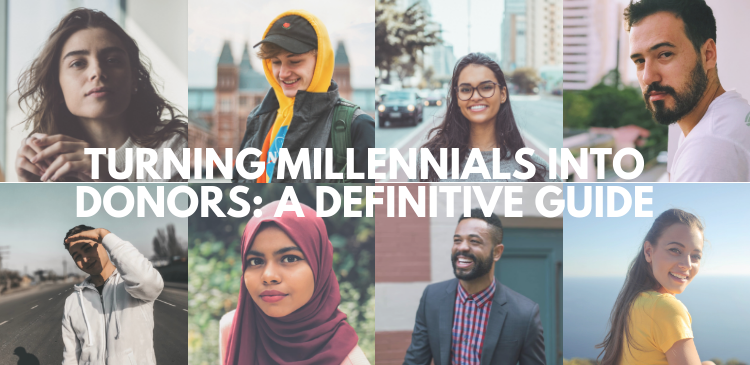

Actionable tips and methods for nonprofits looking to reach and engage millennials as active donors
Millennials--the generation rapidly changing the way we eat, work, exercise, shop, and now, the way we give. Characterized as the generation born between 1980 and 2000, millennials today range from the ages 18 to 38. With millennials now making up the largest portion of the population, it is imperative that nonprofits begin engaging and securing them as donors. But despite making up more than a quarter of the population, millennials account for only 11% of charitable giving.
This may come as a surprise, but millennials have really good intentions. Often referred to as the purpose-driven generation, millennials care about doing social good and yearn to make an impact on the world around them. But there’s a problem--according Blackbaud’s Next Generation of American Giving study, only 25% of millennials believe that monetary giving is the best way to make a difference with charitable organizations.
So how can you, as a nonprofit, turn well-meaning, “I’m-going-to-save-the-world” millennials into tangible donors? And even better--how can you turn them into recurring donors? In this guide, I cover seven approaches that will help your nonprofit both involve and capture the millennial generation.
- Chapter 1: 3 ways to get Millennials directly engaged with your organization
- Chapter 2: Generate Social Currency (aka Millennial Candy)
- Chapter 3: 4 Methods of Transparency that Millennials Love
- Chapter 4: How To Make Your Social Media Attractive and Effective
- Chapter 5: Turn the Tables By Getting Millennials To Fundraise For You
- Chapter 6: How to get Millennials to Pull the Trigger and Donate (in 2 minutes)
- Chapter 7: Turning One-Time Donors into Lifetime Donors
Chapter 5: Turn the Tables By Getting Millennials To Fundraise For You
Who is better at engaging millennials than millennials themselves? Millennials like to think of themselves as “world changers” or “social catalysts”. They not only want to support good work being done, they want to be involved in getting that good work done (it’s all part of their search for purpose). So what better way to get them involved by motivating them to fundraise for the organization they love?How do you do this? Peer-to-peer fundraising. This is a special form of crowdfunding--that buzzword you’ve probably heard thrown around the nonprofit space lately. Crowdfunding is where millennials shine when it comes to giving--making up about 33% of giving to crowdfunding campaigns versus only 11% of traditional charitable giving. The Dressember Foundation is a perfect example of how a simple peer-to-peer campaign can raise millions of dollars for an organization. What started as a campaign consisting of one woman wearing a dress every single day in December to raise awareness for slavery and sex trafficking has transformed into a foundation that has raised over $5 million since 2013.
Pulling off a successful crowdfunding campaign is actually easier than you’d think. I’ve put it together in a simple formula:
[ Campaign + Advocates + Action + Crowdfunding Platform= SUCCESS!]
- Campaign: What are you raising money for? You can make this broad as your organization’s general mission or as specific as a certain project you want to complete. Make sure it’s a cause that will tug at people’s hearts a little bit (aka don’t fundraise for your marketing budget). Be sure to set a clear and attainable goal for how much you want to raise in your campaign.
- Advocates:Create a call to action for people (especially your lovely millennials) to sign up to be an advocate for your campaign. This is the tricky part, in order to have a successful peer-to-peer campaign, you need to make sure you capture those millennials who really love your cause. Reach out to past interns or intern applicants, volunteers, college chapters, and make sure to use your social media.
**Millennials love being advocates for a campaign because it is a goldmine of social currency - Action: Give your advocates an action to perform. For Dressember, this action was wearing a dress for every day in December. Other nonprofits use peer-to-peer fundraising for events such as running a marathon. Give your action some sort of challenge (so that people will be willing to support your advocates in their venture) but also simple enough that you don’t eliminate potential advocates.
- Crowdfunding Platform: Find a crowdfunding platform to launch your campaign on. Classy, CrowdRise, and Rally, are just a few of the many platforms designed for nonprofits to set up their peer-to-peer campaigns.
Looking for the full e-book?
Fill out this form to receive our free guide Millennials To Donors
Now I’ll turn it over to you. What do you think of this guide? Is there anything I missed or you want to see covered? Please send me your thoughts at laura@flourishchange.com.
Laura Soundy
Originally from Sioux Falls, South Dakota, Laura graduated from Baylor University and joined our team in June, 2018. Throughout her college career, she planned and directed multiple fundraising events that raised thousands of dollars for the organizations she was involved with. Outside of the office, Laura loves to compete in sports, play piano, and spend time with friends. She plans to eventually pursue a law degree and continue to work in the nonprofit space.

Flourish began with a simple question:
How can people of all ages — particularly the younger generation — give to and engage with the organizations, and causes, they care about?
Navigation
Legal
Contact Us
© 2018 Copyright Flourish. All Rights Reserved.
Made with Love by Flourish Change, Inc. in Austin, TX
